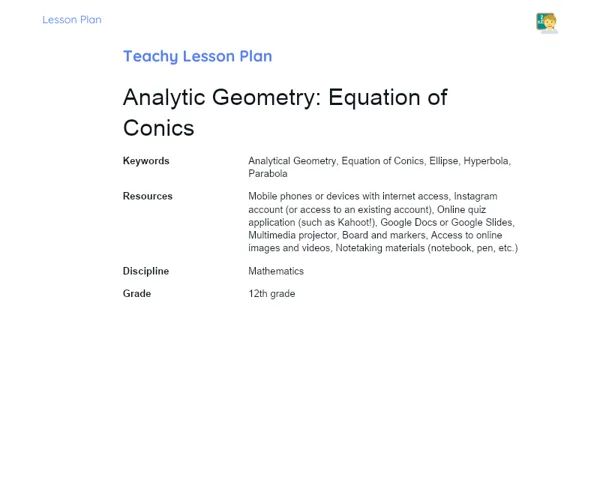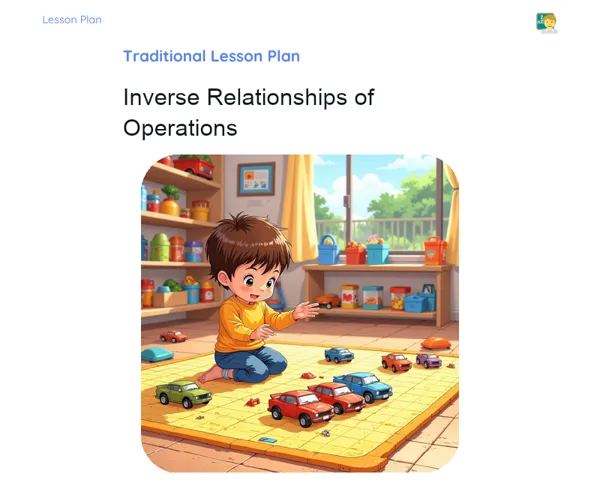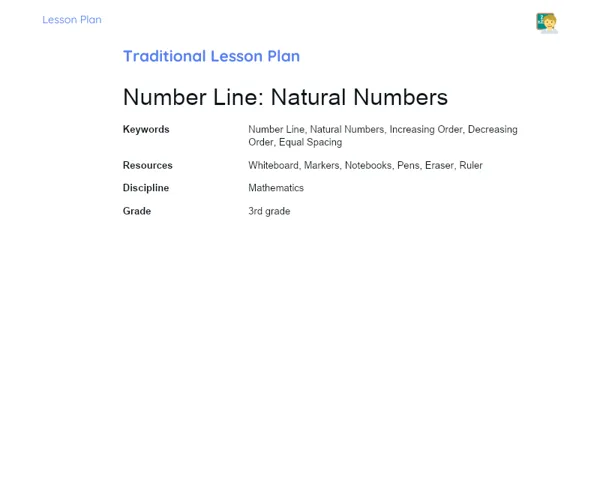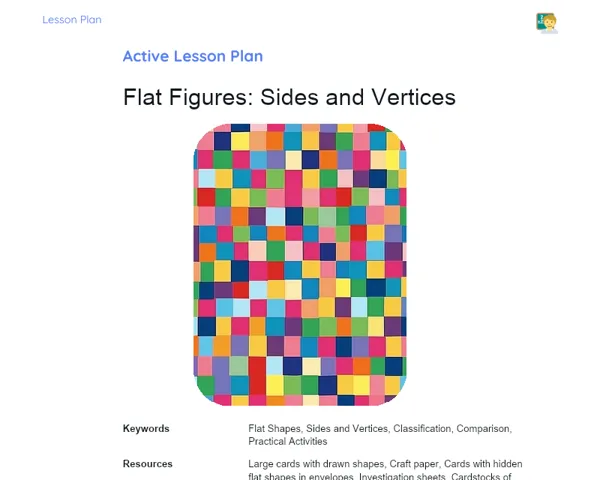Lesson Plan | Lesson Plan Iteratif Teachy | Inequalities: Introduction
| Keywords | Inequalities, Digital Methodology, Basic Mathematics, Active Learning, 7th Grade, Participatory Learning, Gamification, Student Engagement, Digital Technologies, Mathematical Skills |
| Resources | Mobile phones or computers with internet access, Online puzzle platform (e.g., Kahoot), Shared document (Google Docs), Video editing apps (e.g., Canva, iMovie), Tools for creating digital presentations (Google Slides, PowerPoint) |
| Codes | - |
| Grade | 7th grade |
| Discipline | Mathematics |
Goal
Duration: 10 - 15 minutes
This stage aims to set clear learning objectives, guiding students towards understanding and applying basic first-degree inequalities. These definitions will steer upcoming practical activities and connect students to previously studied content.
Goal Utama:
1. Understand the definition and notation of basic first-degree inequalities.
2. Apply techniques to solve inequalities such as greater than, less than, greater than or equal to, and less than or equal to.
Goal Sekunder:
- Relate inequalities to real-life situations students encounter daily.
- Foster skills in interpreting and solving mathematical problems.
Introduction
Duration: 15 - 20 minutes
📖 Purpose: This stage is designed to spark engagement from the get-go, fostering curiosity and connecting the topic to students' everyday lives. This not only helps establish a personal link to the content but also activates prior knowledge, prepping them for active involvement in the next activities.
Warming Up
📱 Warm-Up: Inequalities are essential mathematical tools for comparing values and setting boundaries. But more than just numbers, they aid us in making informed choices in daily life. Ask the students to use their cell phones to discover an interesting fact about inequalities, such as their role in economics, data science, or even in social media algorithms. Each student or group should share their findings with the class.
Initial Thoughts
1. ❓ What interesting fact did you find about inequalities?
2. ❓ How do you think inequalities can be applied in your daily life?
3. ❓ Can you think back to a time you (unknowingly) used an inequality to make a decision?
4. ❓ What are the main differences between an equation and an inequality?
5. ❓ What symbols represent inequalities and what does each mean?
Development
Duration: 60 - 70 minutes
This stage is all about giving students the chance to apply and deepen their understanding of inequalities in a practical context. These activities promote collaboration, creativity, and the use of digital tech, making learning dynamic and relevant to their realities.
Activity Suggestions
Activity Recommendations
Activity 1 - 🕵️♂️ Detective Inequalities
> Duration: 60 - 70 minutes
- Goal: Apply knowledge of inequalities in a fun and collaborative setting to enhance problem-solving skills creatively.
- Deskripsi Activity: In this fun activity, students will turn into mathematical detectives, solving a set of puzzles based on inequalities to crack a mystery. They'll use their phones and computers to access an online platform that presents real-world challenges involving inequalities.
- Instructions:
-
Form groups of up to 5 students.
-
Access the online puzzle platform (like Kahoot or another gamification tool).
-
Each group will tackle a series of puzzles related to basic first-degree inequalities.
-
Puzzles come in varying difficulty levels; solving each will lead the group to the next.
-
Once all inequalities are solved correctly, students will gather clues to uncover the final mystery.
-
Document your answers and strategies in a shared document (like Google Docs).
Activity 2 - 📸 Influencers of Inequalities
> Duration: 60 - 70 minutes
- Goal: Cultivate communication and creativity skills by presenting inequality concepts in a modern and accessible format.
- Deskripsi Activity: Students will step into the shoes of digital influencers focused on maths. They need to create content for social media explaining the concept of inequalities and how to solve them. The task is to prepare a short video, an Instagram post, or a TikTok that is engaging, clear, and creative.
- Instructions:
-
Form groups of up to 5 students.
-
Choose a format for your digital content: a short video, Instagram post, or TikTok.
-
Plan and script your content, ensuring you include clear explanations of inequalities, real-world examples, and solving tips.
-
Record your content with available cell phones or computers.
-
Use free editing apps (like Canva, iMovie, etc.) to make the material appealing and informative.
-
Share your content in the class group or on a designated platform for evaluation and peer feedback.
Activity 3 - 🌍 Inequalities Around the World
> Duration: 60 - 70 minutes
- Goal: Expand students' understanding of the importance of inequalities and their real-world applications.
- Deskripsi Activity: Students will research how inequalities are applied in various global contexts. Using the internet, they'll explore inequalities in fields like economics, data science, and engineering, creating a digital presentation to share with the class.
- Instructions:
-
Form groups of up to 5 students.
-
Research online about how inequalities are used in various fields worldwide.
-
Select 2-3 practical examples of inequalities in global contexts.
-
Create a digital presentation using tools like Google Slides or PowerPoint to illustrate and explain your examples.
-
Presentations should have images, graphs, and detailed explanations.
-
Each group will explain their findings to the class, highlighting how inequalities are applied in each context and answering questions.
Feedback
Duration: 20 - 25 minutes
📖 Purpose: This stage promotes reflection and sharing of knowledge, offering a space for constructive feedback among students. It helps consolidate learning, enables recognition of strengths and improvement areas, and fosters communication and collaboration skills.
Group Discussion
📬 Group Discussion: Kick off by having each group share their major discoveries and experiences from the activities. Guide the conversation using the following outline:
- Introduction: 'Let's start by sharing what we learned today. Each group has a few minutes to present their key takeaways.'
- Sharing: A representative from each group shares their conclusions.
- General Discussion: 'As you listened to the presentations, what commonalities or differences stood out in the applications of inequalities?'
- Conclusion: 'How can we use what we learned today in our studies or daily life?'
Reflections
1. ❓ How did today’s activities enhance your understanding of inequalities? 2. ❓ What was the biggest challenge your group faced, and how did you overcome it? 3. ❓ How did using technology and social media shape your learning about inequalities?
Feedback 360º
🔄 360° Feedback: Instruct students to have a 360° feedback session where every student gives and receives feedback from their peers. Encourage a focus on constructive and respectful feedback using these guidelines:
- Positive Feedback: Each student highlights something positive about a peer's participation.
- Areas for Improvement: Share an area in which the peer can improve.
- Experiences: Prompt students to discuss how their collaboration deepened their understanding of inequalities.
Conclusion
Duration: 10 - 15 minutes
📖 Purpose: This stage aims to wrap up the knowledge gained in an engaging and enjoyable manner, reinforcing the importance of inequalities in modern life. By connecting the content to real-world scenarios, we strive to ensure students understand the relevance of the topic and feel inspired to apply these concepts in their everyday lives. 🌟
Summary
📚 Fun Summary: To grasp inequalities, think of it as being in an RPG game where each quest involves defeating mathematical monsters with specific strategies. We learned to utilise the magic symbols (> , < , ≥ , ≤) to determine which values of X conquer each challenge. Embracing inequalities is akin to solving escape room puzzles – every step inches us closer to the final solution, making us feel like skilled mathematical detectives! 🕵️♂️🔍
World
🌍 In Today's World: Inequalities are omnipresent! From managing social media algorithms to financial decision-making or even calculating queues at amusement parks. They empower us to make smart and efficient choices, enhancing overall connectivity and optimisation. After all, our lives are a complex puzzle of numbers and rules we need to understand to navigate effectively! 📱⚡
Applications
✨ Applications: Understanding inequalities is essential for tackling everyday challenges, from figuring out how many items we can buy on a limited budget to optimising transport routes for efficiency. These mathematical skills help us make logical and informed decisions in various scenarios, whether straightforward or complicated. 💰🚀



